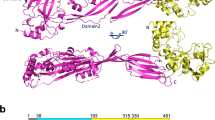Abstract
Streptococcus pneumoniae is a gram positive encapsulated bacterium responsible of septicaemia and upper respiratory infections in children. This pathogen requires iron to survive in the host, which it can obtain of haemoglobin (Hb) or haem. Only two Hb-binding membrane proteins have been identified up to now. However it is unknown whether this pathogen secretes proteins in order to scavenge iron from the Hb or haem. Therefore, in order to explore these possibilities, cellular growth of S. pneumoniae was tested with several alternative iron supplies. The bacterial growth was supported with iron, Hb and haem. Additionally, S. pneumoniae expressed and secreted a protein of 38 kDa which was purified and characterized as Hb and haem-binding protein. This protein was also identified by mass spectrometry as glyceraldehyde-3-phosphate dehydrogenase. Our overall results suggest that S. pneumoniae secretes a protein capable of binding two usefull iron sources for this bacterium (Hb and haem). This protein could be playing a dynamic role in the success of the invasive and infective processes of this pathogen.







Similar content being viewed by others
References
Andrews SC, Robinson AK, Rodríguez-Quiñones F (2003) Bacterial iron homeostasis. FEMS Microbiol Rev 27:215–237
Asuthkar S (2007) Expression and characterization of an iron-regulated hemin-binding protein, HbpA, from Leptospira interrogans serovar. Lai. Infect Immun 75:4582–4591
Brown JS, Gilliland SM, Holden DW (2001) A Streptococcus pneumoniae pathogenicity island encoding an ABC transporter involved in iron uptake and virulence. Mol Microbiol 40:572–585
Brown JS, Gilliland SM, Ruiz-Alber J, Holden DW (2004) Characterization of pit, a Streptococcus pneumoniae iron uptake ABC transporter. Infect Immun 70:4389–4398
Choi CW, Lee YG, Kwon SO, Kim HY, Lee JC, Chung YH, Yun CY, Kim SI (2012) Analysis of Streptococcus pneumoniae secreted antigens by immuno-proteomic approach. Diagn Microbiol Infect Dis 4:318–327
Cruz-Castañeda A, López-Casamichana M, Olivares-Trejo JJ (2011) Entamoeba histolytica secretes two haem-binding proteins to scavenge haem. Biochem J 434:105–111
Erales J, Lignon S, Gontero B (2009) CP12 from Chlamydomonas reinhardtii, a permanent specific “chaperone-like” protein of glyceraldehyde-3- phosphate dehydrogenase. J Biol Chem 284:12735–12744
González-López MA, Velázquez-Guadarrama N, Romero-Espejel ME, Olivares-Trejo JJ (2013) Helicobacter pylori secretes the chaperonin GroEL (HSP60), which binds iron. FEBS Lett 587:1823–1828
Hannibal L, Collins D, Brassard J, Chakravarti R, Vempati R, Dorlet P, Santolini J, Dawson JH, Stuehr DJ (2012) Heme binding properties of glyceraldehyde-3-phosphate dehydrogenase. Biochemistry 51:8514–8529
Mazzola JL, Sirover MA (2001) Reduction of glyceraldehyde-3-phosphate dehydrogenase activity in Alzheimer’s disease and in Huntington’s disease fibroblasts. J Neurochem 76:442–449
Miller JH (1972) Experiments in molecular genetics. Cold Spring Harbor Laboratory, Cold Spring Harbor
Oliveira L, Madureira P, Andrade EB, Bouaboud A, Morello E, Ferreira P, Poyart C, Trieu-Cuot P, Dramsi S (2012) Group B streptococcus GAPDH is released upon cell lysis, associates with bacterial surface, and induces apoptosis in murine macrophages. PLoS One 7(1):e29963
Pancholi V, Chhatwal GS (2003) Housekeeping enzymes as virulence factors for pathogens. Int J Med Microbiol 293:391–401
Reidl J, Mekalanos JJ (1996) Lipoprotein e(P4) is essential for hemin uptake by Haemophilus influenzae. J Exp Med 183:621–629
Romero-Espejel ME, González-López MA, Olivares-Trejo JJ (2013) Streptococcus pneumoniae requires iron for its viability and expresses two membrane proteins that bind haemoglobin and haem. Metallomics 5:384–389
Simpson W, Olczak T, Genco CA (2000) Characterization and expression of HmuR, a TonB-dependent hemoglobin receptor of Porphyromonas gingivalis. J Bacteriol 182:5737–5748
Sirover MA (1996) Minireview. Emerging new functions of the glycolytic protein, glyceraldehyde-3-phosphate dehydrogenase, in mammalian cells. Life Sci 58:2271–2277
Sirover MA (2011) On the functional diversity of glyceraldehyde-3-phosphate dehydrogenase: biochemical mechanisms and regulatory control. Biochim Biophys Acta 10:741–751
Tai SS, Lee CJ, Winter RE (1993) Hemin utilization is related to virulence of Streptococcus pneumoniae. Infect Immun 61:5401–5405
Torres VJ, Pishchany G, Humayun M, Schneewind O, Skaar EP (2006) Staphylococcus aureus IsdB is a hemoglobin receptor required for heme iron utilization. J Bacteriol 188:8421–8429
Tuomanen EI, Mitchell TJ, Morrison D, Spratt BG (2004) The Pneumococcus. ASM Press, Washington, DC, USA
Vanet A, Labigne A (1998) Evidence for specific secretion rather than autolysis in the release of some Helicobacter pylori proteins. Infect Immun 66:1023–1027
Wandersman C, Delepelaire P (2004) Bacterial iron sources: from siderophores to hemophores. Annu Rev Microbiol 58:611–647
Wandersman C, Stojiljkovic I (2000) Bacterial heme sources: the role of heme, hemoprotein receptors and hemophores. Curr Opin Microbiol 3:215–220
Acknowledgments
This work was supported by CONACyT (Consejo Nacional de Ciencia y Tecnología) (Grant numbers SALUD-2010-01-139945, SALUD-2012-01-181641). We thank Ms. D. Alma Lidia Olivares from Hospital Infantil de México “Federico Gómez” for providing the R6 strain used in this study.
Author information
Authors and Affiliations
Corresponding author
Additional information
Zelene Edith Vázquez-Zamorano and Marco Antonio González-López have contributed equally to this work.
Rights and permissions
About this article
Cite this article
Vázquez-Zamorano, Z.E., González-López, M.A., Romero-Espejel, M.E. et al. Streptococcus pneumoniae secretes a glyceraldehyde-3-phosphate dehydrogenase, which binds haemoglobin and haem. Biometals 27, 683–693 (2014). https://doi.org/10.1007/s10534-014-9757-0
Received:
Accepted:
Published:
Issue Date:
DOI: https://doi.org/10.1007/s10534-014-9757-0




